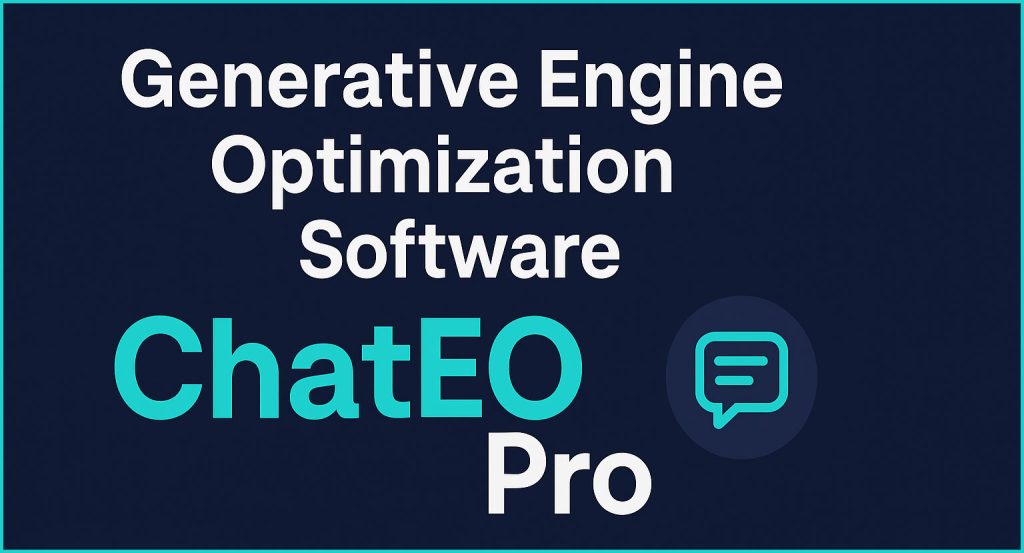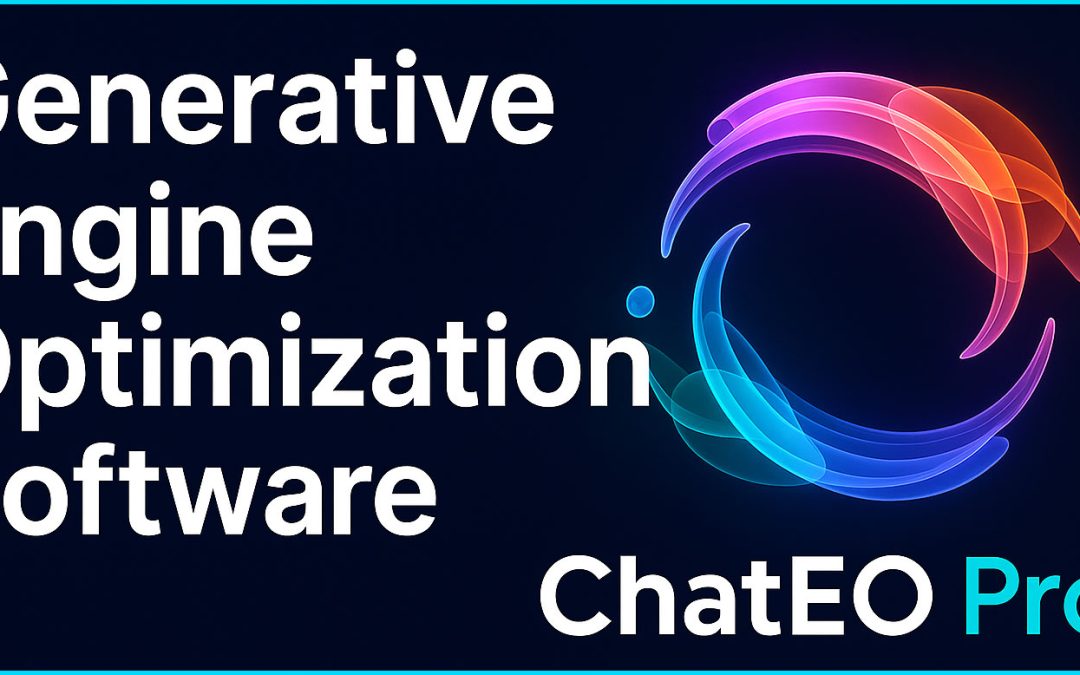Generative Engine Optimization Software by ChatEO Pro Software
Page Contents
- Generative Engine Optimization Software by ChatEO Pro Software
- ChatEO Pro – Unlocking the AI Answer Layer for Brands
- What is Generative Engine Optimization (GEO)?
- Key Features of ChatEO Pro
- Benefits of Using ChatEO Pro
- How ChatEO Pro Leverages Generative AI
- Challenges of Implementing GEO
- Developing Effective GEO Strategies
- Measuring GEO Success
- Future of GEO and SEO Integration
ChatEO Pro – Unlocking the AI Answer Layer for Brands
What We’ve Built:
ChatEO Pro is the missing optimization layer for the AI-dominated interface. We help brands track, influence, and scale their presence inside LLM-powered answers — the kind delivered by ChatGPT, Gemini, Claude, and Perplexity.
In the ever-evolving digital landscape, staying at the forefront of search engine optimization has become crucial for success. As traditional SEO methods give way to more advanced technologies, the emergence of Generative Engine Optimization (GEO) marks a new chapter in digital marketing. Generative AI has begun to play a pivotal role in shaping search algorithms, altering how content is created and consumed online.
Enter ChatEO Pro, a cutting-edge tool designed to optimize content generation through the power of Generative AI. By blending traditional SEO practices with innovative GEO strategies, ChatEO Pro promises enhanced user engagement, improved content quality, and increased visibility in search results. This software not only focuses on domain-specific optimization but also integrates seamlessly with existing SEO frameworks to ensure sharp, intent-specific targeting for businesses.
This article delves into the transformative qualities of ChatEO Pro, exploring its key features and benefits, while acknowledging the challenges of implementing GEO in today’s complex digital landscape. We’ll uncover how leveraging generative AI can refine content creation, analyze critical performance metrics, and forecast the future intersection of GEO and SEO technology.
What is Generative Engine Optimization (GEO)?
Generative Engine Optimization (GEO) is a modern approach to enhance content visibility specifically for AI-driven generative engines. Unlike traditional search engine optimization (SEO), GEO shifts the focus toward optimizing content so that AI systems can understand and synthesize it effectively. These AI-driven engines interpret information and provide users with comprehensive responses to their queries. GEO ensures that AI tools such as ChatGPT and Google’s AI Search easily access, evaluate, and accurately represent a brand’s message. Success in GEO hinges on well-structured and credible content following the EEAT principles: Experience, Expertise, Authoritativeness, and Trustworthiness. This optimization is vital as more users rely on AI-generated responses, moving the focus away from outdated keyword-centric strategies. GEO marks a significant shift, ensuring continued online visibility and engagement in a rapidly changing digital landscape.
Evolution from Traditional SEO to GEO
GEO represents a significant evolution from traditional SEO, as it’s tailored for AI-driven search engines rather than conventional ones. Traditional SEO prioritizes keyword usage and backlinks to improve search engine results pages (SERPs). In contrast, GEO prioritizes aligning content with generative search models that emphasize context and AI-generated responses. Unlike traditional algorithms that rank based on keywords, GEO caters to AI platforms that deliver context-rich responses synthesized from multiple sources. The rise of GEO highlights the need to create content that AI technologies can easily access, ensuring user engagement and maintaining credibility. This evolution in digital strategy allows businesses to boost their online presence and stay relevant in this AI-empowered era.
The Role of Generative AI in GEO
Generative Engine Optimization is about refining content specifically for AI-driven search engines that provide comprehensive responses. Instead of relying on indexed and ranked web pages, generative AI engines deliver real-time solutions to user queries. Tools like ChatGPT and Perplexity transform user interaction into a more personalized experience. Generative AI reshapes search interactions by offering contextual, tailored responses that enhance user engagement. Brands can boost visibility by crafting content that is authoritative and informative, aligning perfectly with AI capabilities and expectations. As AI supports more creative and context-rich solutions, it becomes imperative for brands to adapt their content strategies to maintain relevance and visibility in AI-generated results.

Key Features of ChatEO Pro
ChatEO Pro is a tool designed to boost brand visibility and relevance within AI-generated responses. By focusing on generative engine optimization, it ensures content aligns with AI-driven search engines like ChatGPT and Google’s Bard. Unlike traditional SEO, which often relies on meta tags and keywords, ChatEO Pro ensures AI systems grasp the broader context and nuances of the content. This optimizes a brand’s online presence by leveraging large language models for coherence and relevancy in responses. The software also enables brands to be cited effectively, heightening their presence in AI responses through strategic content structuring that fits AI synthesis capabilities.
Enhanced Content Creation
Enhanced content creation is a cornerstone of Generative Engine Optimization (GEO). It involves crafting high-quality digital content designed for AI-driven search engines. A study from Princeton and Georgia Tech highlights how domain-specific adjustments can boost visibility. Including citations, quotations, and statistics increases source visibility by up to 40%. GEO promotes writing that appeals not only to readers but also resonates with AI platforms, ensuring broader engagement. The research underlines the importance of unique words, fluency, and authoritative sources. These elements are vital for boosting content’s visibility in AI-generated responses, providing valuable insights and enhancing digital marketing strategies.
User Experience and Engagement
Generative Engine Optimization aligns content with user intent to enhance user satisfaction. AI-driven search engines grasp deeper contexts, which helps well-optimized content surface more often in complex queries. This increases both discoverability and user engagement. GEO encourages integrating visuals and interactive elements to boost user appeal and accessibility. Generative AI tools, like Google’s AI Overviews, offer enriched, personalized responses, leading to a seamless user experience. Using engaging language and a conversational tone aligns with how generative AI interacts with users. This approach can boost engagement and content relevance, making the digital landscape more vibrant and interactive.
Domain-Specific Optimization
Domain-specific optimization varies by field, requiring tailored methods for optimal outcomes. In science and technology, using technical terms and a formal style boosts visibility, as the audience demands precise information. In the arts and humanities, quotations and reputable sources enhance visibility, aligning with the audience’s appreciation for depth. For business and finance, including statistics and data-driven insights improves visibility, meeting the need for actionable content. Science and health domains benefit from fluency, which improves clarity and engagement. Each approach in these domains is crucial for achieving high content visibility and engaging the target audience effectively.
Intent-Specific Targeting
Intent-specific targeting was not directly covered in the guidelines, but it involves understanding user needs and tailoring content to fulfill those needs. This approach ensures that content is not only relevant but also satisfying to the user’s query. By focusing on the user’s intent, content developers can enhance engagement and effectiveness. Tailoring content this way improves the match between the user’s search and the results, providing a more successful interaction. While it wasn’t specifically mentioned, similar GEO techniques can be applied to improve content visibility and relevance, aiding in generating comprehensive and valuable search engine responses.
Benefits of Using ChatEO Pro
ChatEO Pro transforms the user experience by offering a smoother interaction than traditional search engines. By using advanced Generative AI, ChatEO Pro modernizes how information is found and shared. This software helps users get quick answers with less hassle, thanks to natural language processing. The search layout of ChatEO Pro is clear and uncluttered, which means users find what they need more easily. Embracing AI-driven capabilities, ChatEO Pro is part of a new wave in digital search technologies. It reflects the industry’s move towards generative AI solutions, making search engine optimization more effective and up-to-date.
Improved Visibility in Search Results
Generative Engine Optimization (GEO) significantly boosts content visibility by meeting the needs of AI-driven search engines. GEO focuses on making content clear, relevant, and authoritative. By incorporating quotations, statistics, and direct answers, content can secure higher rankings in AI-generated search results. This strategy adapts traditional SEO techniques to suit the requirements of chat-based engines like ChatGPT and Gemini. By ensuring content is engaging and authoritative, GEO enhances its discovery through conversational interactions. Implementing credible citations and authoritative sources within content can improve visibility in generative engine responses by up to 40%.
Greater Content Relevance and Quality
The focus of Generative Engine Optimization (GEO) is on enhancing content quality that aligns with AI algorithms. It ensures content is both contextually accurate and responsive to user queries. GEO encourages the creation of content with conversational elements and authoritative claims, improving engagement and boosting AI-driven search rankings. High-quality content is vital within the GEO framework for achieving better visibility on AI-specific search engine results pages (SERPs). By optimizing content to be comprehensive and authoritative, GEO aligns it with the capabilities of generative engines. Both traditional SEO and GEO stress the importance of the E-E-A-T principles, which emphasize experience, expertise, authoritativeness, and trustworthiness.
Integration with Existing SEO Practices
By 2025, many businesses started integrating GEO practices with their existing SEO strategies. Recognizing its importance, companies use GEO as a crucial element to maintain visibility in AI-generated content alongside traditional SEO methods. Traditional SEO often focused on keyword density and backlinks. However, GEO emphasizes authority and context, which can be seamlessly integrated into current SEO strategies. A balanced approach, combining both SEO and GEO practices, is essential as AI-driven search engines coexist with traditional ones. With the rise of generative AI, optimizing websites for both traditional and AI platforms is necessary, requiring integration within existing SEO strategies.
How ChatEO Pro Leverages Generative AI
ChatEO Pro is at the forefront of using Generative Engine Optimization (GEO) to enhance brand content in the digital landscape. This tool is essential for boosting visibility and relevance within AI-driven search engines. By fine-tuning content for these engines, ChatEO Pro helps brands stand out among the countless options available online. It focuses on crafting authoritative and engaging content that both search engines and users find valuable. This approach ensures that brands not only improve their online presence but also build stronger relationships with their audience. With data-driven strategies, ChatEO Pro keeps pace with changing trends and ensures that its GEO tactics align with marketing goals, enhancing overall brand engagement.
The Function of Large Language Models (LLMs)
Large Language Models (LLMs) like ChatGPT play a pivotal role in the function of generative engines. These models are trained on vast datasets, enabling them to grasp and interpret complex language and context. Unlike traditional search engines that focus on keywords, LLMs synthesize data from various sources to deliver comprehensive and nuanced responses. Their ability to update with new information ensures they remain current and responsive to user needs. By integrating multiple data sources, LLMs offer a sophisticated blend of traditional and generative search capabilities. This powerful technology allows LLMs to provide more personalized and human-like interactions, making them instrumental in AI-driven searches.
Techniques for Optimizing Content
Generative Engine Optimization (GEO) combines traditional SEO methods with AI-driven tactics to improve content visibility in AI-based search engines. By focusing on content structure, GEO ensures that AI models can easily summarize and comprehend the information. A key component of this is using authoritative sources and embedding direct answers and statistics into the content. This strategy enhances ranking in AI-generated searches. Additionally, tailoring content for AI engines like ChatGPT requires an emphasis on relevance, clarity, and persuasive language. This ensures that content is discoverable and aligns with the evolving nature of AI-specific search features. Leveraging GEO techniques positions brands effectively in search results and caters to the changing user behavior in the digital world.
Challenges of Implementing GEO
Generative Engine Optimization (GEO) introduces a new set of challenges for content creators accustomed to traditional SEO practices. The nature of AI-driven search, particularly the use of complex generative engines, limits control over content visibility. This lack of control stems from the “black box” nature of AI systems that generate context-rich answers rather than simple listings. Unlike traditional search engines which rank pages based on keywords and links, generative engines synthesize user input to provide comprehensive responses. As these engines evolve, understanding how to navigate this new terrain becomes increasingly complex. Furthermore, GEO demands the development of new impression metrics for generative engines, adding another layer of intricacy to assessing the effectiveness of optimization strategies.
The landscape of Generative Engine Optimization is markedly different from traditional SEO. GEO focuses on refining content for AI-driven models like ChatGPT and Google AI. These systems interpret the broader context rather than just relying on keywords, making the synthesis of information into concise summaries a priority. Traditional SEO tactics centered on building backlinks and optimizing keyword placement aren’t as effective here. Instead, GEO success hinges on creating clear and structured content. This ensures that AI platforms can easily understand and process information following the principles of Experience, Expertise, Authoritativeness, and Trustworthiness (E-E-A-T). With generative engines, it’s crucial to stay updated on new trends and consistently assess performance since these AI search tools value content quality and credibility over sheer keyword presence.
Balancing GEO with Traditional SEO
Balancing Generative Engine Optimization with traditional SEO requires a nuanced understanding of AI’s role in content generation. Traditional SEO has long relied on optimizing websites for search engine results through keywords and link-building. GEO, however, prioritizes content quality and its relevance to user intent. It seeks to provide meaningful and comprehensive responses to AI-driven search engines. This user-centric approach demands that content creators not only focus on keyword placement but also consider the context and purpose of user queries. As generative engines use real-time data points to offer detailed answers, aligning with evolving AI algorithms is essential. This ensures that content remains credible and high-quality, capturing the benefits of both GEO and traditional SEO strategies.
Developing Effective GEO Strategies
Generative Engine Optimization (GEO) is essential for having AI models like ChatGPT, Gemini, and Perplexity include your content in their responses. Unlike the methods used for traditional search engines, GEO requires a deeper understanding of how AI systems process and display data. These systems don’t rely on indexing or ranking but focus on generating comprehensive responses. Therefore, effective GEO strategies call for different optimization techniques. To succeed, it’s crucial to produce high-quality content and manage digital assets. This ensures that you have control over content performance in AI-generated overviews. Given the black box nature of AI engines, strategies must concentrate on impression metrics and evaluation frameworks. This focus enhances content visibility effectively in the generative AI landscape.
Adapting to Evolving User Search Behavior
The way users search and consume information is changing rapidly due to the rise of AI-driven search platforms. Integrating GEO into your digital strategy is key to staying relevant. As more people turn to AI-driven tools for search and purchasing decisions, businesses need to ensure their content is visible in the results generated by these AI models. This shift highlights the need for businesses to embrace GEO strategies. By doing so, companies can improve their brand’s visibility and capture user attention better than competitors who stick to traditional methods. The demand for personalized and comprehensive search responses makes this adaptation not just advantageous but necessary for sustained success in the digital landscape.
Continuous Experimentation and Iteration
To master GEO, continuous experimentation is vital. This process helps in identifying which methods outshine traditional SEO strategies. By systematically analyzing diverse queries, businesses gather empirical data that inform best practices. Regular iteration allows for testing different techniques, like fluency and citation optimization. This is crucial for improving AI-generated responses. Incorporating elements like quotes and statistics has shown marked improvements in performance metrics. For structured analysis and refinement of GEO strategies, a framework known as GEO-BENCH is valuable. This approach helps businesses fine-tune their generative engine tactics, ensuring a competitive edge.
Measuring GEO Success
Generative Engine Optimization (GEO) is vital in today’s digital world, particularly as AI-driven search engines grow in relevance. For a GEO strategy to be considered successful, it must be measured accurately. This process involves using impression metrics as a framework. Impressions provide a glimpse into how often content appears for relevant queries. It’s crucial to track traffic and conversion rates to ensure that content is effectively optimized according to GEO best practices. Key performance indicators (KPIs) are essential tools for evaluating the success of GEO strategies. These indicators offer valuable insights into impressions and help assess the overall impact of your GEO efforts. Regular reviews of content performance aligned with GEO principles are necessary. By implementing these strategies, an average improvement in impression metrics by 30% can be achieved. This underlines the potential of effective generative engine optimization.
Important Performance Metrics and KPIs
To fully understand the effectiveness of GEO strategies, it’s important to focus on key performance metrics and KPIs. GEO strategies, when implemented properly, can lead to a significant increase in impressions, with an average improvement of 30%. This highlights the value of employing these strategies. To gauge the performance of content, it is essential to monitor traffic and conversions. These metrics provide a clear picture of whether your GEO strategies are working in alignment with best practices.
Tracking impression metrics for generative engines is crucial. These metrics serve as vital indicators of how effective your GEO strategies truly are. Monitoring the presence of dates in search engine results pages (SERPs) can also offer valuable forecasting information. It helps predict which content is most likely to be pulled from web indexes.
Another useful tool is Paid Search Reporting. This can reveal how often people include specific years in their queries. By understanding this, you can refine your GEO strategies to better target user intents. This combination of tracking and analyzing key metrics is essential to maximize the potential of GEO.
Impact on Organic Search Traffic
Generative Engine Optimization (GEO) has a notable impact on organic search traffic. As more users turn to AI platforms like ChatGPT for answers, the traditional search engines face changes. Generative AI sees users starting their searches on these AI-driven platforms. As a result, this shift affects organic search traffic derived from traditional search engines.
Transitioning from traditional SEO to a GEO approach involves a focus on optimizing for AI systems. This can change the way organic search results are both generated and consumed. Unlike traditional SEO that emphasizes volume, GEO highlights content relevance. This difference in focus can affect how organic search traffic is both achieved and measured.
As generative AI search engines continue to evolve, maintaining organic search traffic demands new strategies. These strategies should incorporate conversational and intent-based search practices. By aligning with user queries and intent, businesses can better navigate this new digital landscape. Understanding and adapting to these changes is crucial for sustaining traffic in the evolving world of GEO.
Future of GEO and SEO Integration
Generative Engine Optimization (GEO) and Search Engine Optimization (SEO) are shaping digital marketing’s future. GEO uses AI-driven search engines that focus on user intent, context, and relevance beyond simple keywords. While SEO has long been the standard for online visibility, GEO offers a new layer by aligning content with advanced search technologies, thus complementing traditional methods rather than replacing them. By using large language models (LLMs), GEO can transform how information is gathered and presented. This change requires optimizing content for generative engines using methods like schema markup and high-quality distribution. A balanced approach, blending SEO and GEO, is key to maintaining and enhancing visibility as AI technologies evolve.
Trends in Search Technology
As generative AI evolves, it’s changing how we search online. This makes Generative Engine Optimization (GEO) essential to stay visible. Unlike traditional searches that rely on keywords, AI-driven engines focus on user intent and context, providing more relevant answers. With platforms like ChatGPT and Google Bard, this shift is already in motion. According to Gartner, by 2026, traditional search volume may drop by 25%, while organic traffic might fall by over half. This is because more people are using AI-powered searches. By the end of next year, almost eight in ten consumers are expected to trust AI-enhanced searches. Generative Engine Optimization sets itself apart from traditional SEO by aligning with these AI models, ensuring that content remains discoverable and relevant.
Potential Developments in GEO
Generative Engine Optimization (GEO) is gaining momentum fast. By early 2024, it is already seen as crucial in digital marketing and SEO circles. Many companies are incorporating GEO into their strategies by 2025. GEO helps shape content and digital assets to influence the results from AI-driven search engines, complementing traditional SEO techniques. Platforms like ChatGPT and Perplexity offer direct answers, steering clear of typical search results. However, the inner workings of generative engines can be complex. This presents a challenge for creators aiming to boost content visibility. New GEO strategies and metrics are being developed to overcome these challenges and better understand the AI search landscape. As the field advances, GEO proves indispensable in navigating the evolving digital space.



